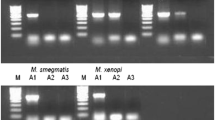Summary
The polymerase chain reaction (PCR) method was used to detect mycoplasma contamination in a panel of 42 continuous cell lines. According to the microbiological cultivation assay on agar, 29 cell lines were chronically infected and 13 cell lines were negative. Sets of outer and inner primers (nested double-step PCR) were applied which anneal to DNA sequences coding for conserved regions of the 16S rRNA. These oligonucleotides allow for the amplification of DNA regions found in at least 25 mycoplasma species (including the ones most commonly found in cell cultures), but do not cross-hybridize with DNA from eukaryotic cells. Mycoplasma-positive cell lines showed distinctive bands in ethidium bromide-stained gels, both after the first round of amplification as well as after the second PCR; all agar-negative cell lines were also unambiguously negative in the PCR assay. Thus, neither false-positive nor false-negative results occurred. Provided that the proper PCR working conditions are scrupulously observed, the PCR amplification has several outstanding advantages: high sensitivity, specificity, reliability, objectivity, speed, and simplicity.
Similar content being viewed by others
References
Blazek, R.; Schmitt, K.; Krafft, U., et al. Fast and simple procedure for the detection of cell culture mycoplasmas using a single monoclonal antibody. J. Immunol. Methods 131:203–212; 1990.
Bölske, G. Survey of mycoplasma infections in cell cultures and a comparison of detection methods. Zbl. Bakt. Mikrobiol. Hyg. A267:510–518; 1988.
Chen, T. T. In situ detection of mycoplasma contamination in cell cultures by fluorescent Hoechst 33258 stain. Exp. Cell Res. 104:255–262; 1977.
Göbel, U. B.; Stanbridge, E. Cloned mycoplasma ribosomal RNA genes for the detection of mycoplasma contamination in tissue cultures. Science 226:1211–1213; 1984.
Hay, R. J.; Macy, M. L.; Chen, T. R. Mycoplasma infection of cultured cells. Nature 339:487–488; 1989.
Higuchi, R. Simple and rapid preparation of samples for PCR. In: Erlich, H. A., ed. PCR technology. Principles and applications for DNA amplification. New York: Stockton Press; 1989:31–43.
Jensen, J. S.; Uldum, S. A.; Sondergard-Anderseb, J., et al. Polymerase chain reaction for detection ofMycoplasma genitalium in clinical samples. J. Clin. Microbiol. 29:46–50; 1991.
Johansson, K. E.; Bölske, G. Evaluation and practical aspects of the use of a commercial DNA probe for detection of mycoplasma infections in cell cultures. J. Biomed. Biophys. Methods 19:158–200; 1989.
Johansson, K. E.; Johansson, I.; Göbel, U. B. Evaluation of different hybridization procedures for the detection of mycoplasma contamination in cell cultures. Mol. Cell. Probes. 4:33–42; 1990.
Kwok, S.; Higuchi, R. Avoiding false positives with PCR. Nature 339:237–238; 1989.
Luczak, J.; Knower, S. A.; Cox, M. S., et al. Mycoplasma contamination detected in cell lines and their products from 1985 to the present. In Vitro Cell. Dev. Biol. 27:122A; 1991.
McGarrity, G. J.; Sarama, J.; Vanaman, V. Cell culture techniques. Am. Soc. Microbiol. 51:170–183; 1985.
McGarrity, G. J.; Kotani, H. Detection of cell culture mycoplasmas by a genetic probe. Exp. Cell Res. 163:273–278; 1986.
Mowles, J. M. The use of ciprofloxacin for the elimination of mycoplasma from naturally infected cell lines. Cytotechnology 1:355–358; 1988.
Razin, S.; Hyman, H. C.; Nur, I., et al. DNA probes for detection and identification of mycoplasma (Mollicutes). Isr. J. Med. Sci. 23:735–741; 1987.
Russell, W. G.; Newman, C.; Williamson, D. H. A simple cytochemical technique for demonstration of DNA in cells infected with mycoplasmas and viruses. Nature 253:461–462; 1975.
Uphoff, C. C.; Gignac, S. M.; Drexler, H. G. Mycoplasma contamination in human leukemia cell lines. I. Comparison of various detection methods. J. Immunol. Methods 149:43–53; 1992.
Uphoff, C. C.; Brauer, S.; Grunicke, D., et al. Sensitivity and specificity of five different mycoplasma detection assays. Leukemia 6:335–341; 1992.
Wirth, M.; Berthold, E.; Grashoff, M., et al. Detection of mycoplasma contaminations by the polymerase chain reaction. J. Clin. Microbiol. Submitted.
Author information
Authors and Affiliations
Rights and permissions
About this article
Cite this article
Hopert, A., Uphoff, C.C., Wirth, M. et al. Mycoplasma detection by PCR analysis. In Vitro Cell Dev Biol - Animal 29, 819–821 (1993). https://doi.org/10.1007/BF02634350
Received:
Accepted:
Issue Date:
DOI: https://doi.org/10.1007/BF02634350




